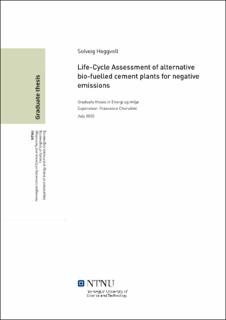| dc.contributor.advisor | Cherubini, Francesco | |
| dc.contributor.advisor | Morales, Marjorie | |
| dc.contributor.author | Heggvoll, Solveig | |
| dc.date.accessioned | 2021-09-20T16:53:30Z | |
| dc.date.available | 2021-09-20T16:53:30Z | |
| dc.date.issued | 2020 | |
| dc.identifier | no.ntnu:inspera:57318108:20919647 | |
| dc.identifier.uri | https://hdl.handle.net/11250/2779664 | |
| dc.description.abstract | Sementindustrien star for store mengder CO ˚ 2-utslipp arlig, og er i dag ansvarlig for om lag ˚
8% av de globale menneskeskapte CO2-utslippene. Ettersom behovet for sement er antatt
a øke i ˚ arene fremover er det viktig ˚ a finne gode løsninger som kan minske utslippene fra ˚
sementproduksjon. Denne oppgaven studerer de miljømessige fordelene og ulempene som
følger med bruken av bio-baserte brenselsstoffer og oxy-fuel karbonfangstteknologi (CCS)
i produksjonen av klinker, hovedbestanddelen i sement. Oppgaven undersøker hvor høy
andel biobrensel som kan brukes og om det er mulig a oppn ˚ a negative CO ˚ 2 utslipp i klinkerproduksjon. Tre forskjellige biobrensler er undersøkt; husholdningsavfall, kloakkslam
og skogsavfall.
En forenklet modell av forbrenningsystemet til sementproduksjon er laget i Aspen Plus for
a simulere forbrenningen av forskjellige sammensetninger av biobrensler og kull. Simu- ˚
leringer er kjørt bade for forbrenning i luft og for oxy-fuel-forbrenning. Disse simulerin- ˚
gene ga informasjon om utslippene fra forbrenningsprosessen i tillegg til a vise hvor høy ˚
andelen med biobrensel kunne være. Livssyklusanalyse (LCA) er brukt for a analysere ˚
miljøpavirkningene man kan f ˚ a av ˚ a bruke biobrensler og oxy-fuel CCS i sementproduk- ˚
sjon.
Resultater fra Aspen Plus simuleringene viser at andelen biobrensel som kan brukes til
sementproduksjon kan økes fra rundt 25-50% til nærmere 100% nar oxy-fuel-forbrenning ˚
er brukt i stedet for vanlig forbrenning i luft. Resultatene fra livssyklusanalysen viser at det
kan være mulig a oppn ˚ a nøytrale CO ˚ 2-utslipp for produksjonen av klinker ved a kombinere ˚
bruken av oxy-fuel CCS og biobrensler. Det virker derimot usannsynlig at det er mulig a˚
oppna negative CO ˚ 2-utslipp. Bade bruken av oxy-fuel CCS og biobrensler medfører noen ˚
miljømessige ulemper, men ut ifra resultatene i denne studien virker det som at de store
miljøfordelene veier opp for ulempene. | |
| dc.description.abstract | The cement industry contributes to large amounts of CO2 emissions yearly and is today responsible for around 8% of global anthropogenic CO2 emissions. With a predicted increase in cement demand in the coming years it is important to find ways to lower the emissions associated to cement production. This thesis studies the environmental benefits and possible negative impacts of using alternative fuels and oxy-fuel carbon capture and storage (CCS) in cement manufacturing. The study looks into how much biofuel can be used in the fuel mix and if it is possible to achieve negative CO2 emissions for production of clinker, the main constituent of cement. Three different biofuels were chosen to obtain more comprehensive results; municipal solid waste, sewage sludge and forest residues.
A simplified model of the cement kiln system is made in Aspen Plus to simulate the combustion of various fuel mixes for both combustion in air and for oxy-fuel combustion. These simulations provided emission information from the combustion process and showed which fuel mixes that could work for cement production. Life cycle assessment (LCA) was used to analyse the environmental impacts associated to using alternative fuels and oxy-fuel CCS.
Results from the Aspen Plus simulations showed that the share of biofuels in the fuel mix could be increased from around 25-50% to around 100% when oxy-fuel combustion was used instead of traditional combustion in air. The results from the LCA show that combined use of biofuels and oxy-fuel CCS has a large CO2 mitigation potential, making neutral emissions from clinker production possible. Achieving negative emissions does however appear to be difficult. The use of both oxy-fuel CCS and biofuels have some environmental trade-offs, but based on this study the environmental benefits appear to outweigh the negative effects. | |
| dc.language | | |
| dc.publisher | NTNU | |
| dc.title | Life-Cycle Assessment of alternative bio-fuelled cement plants for negative emissions | |
| dc.type | Master thesis | |
